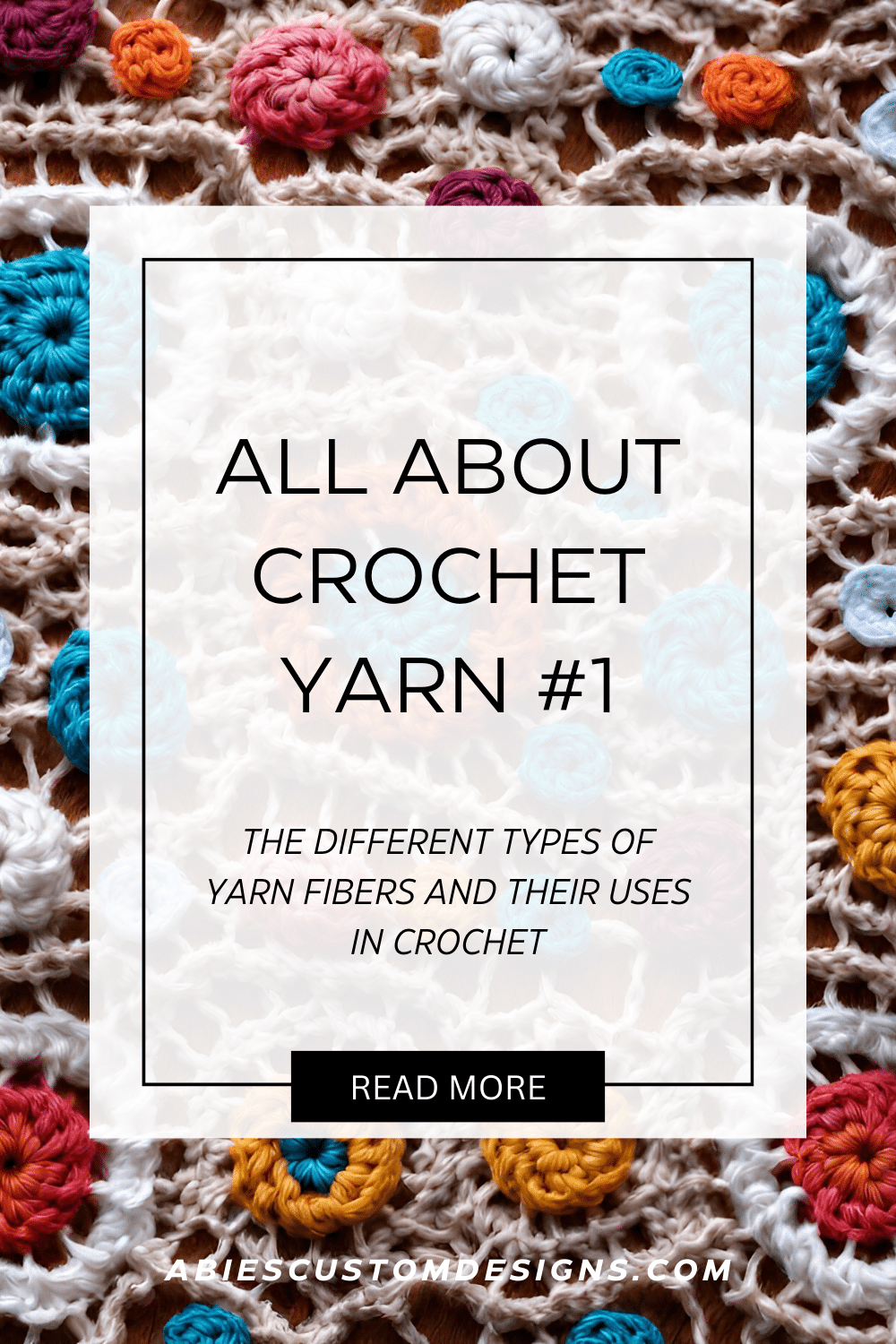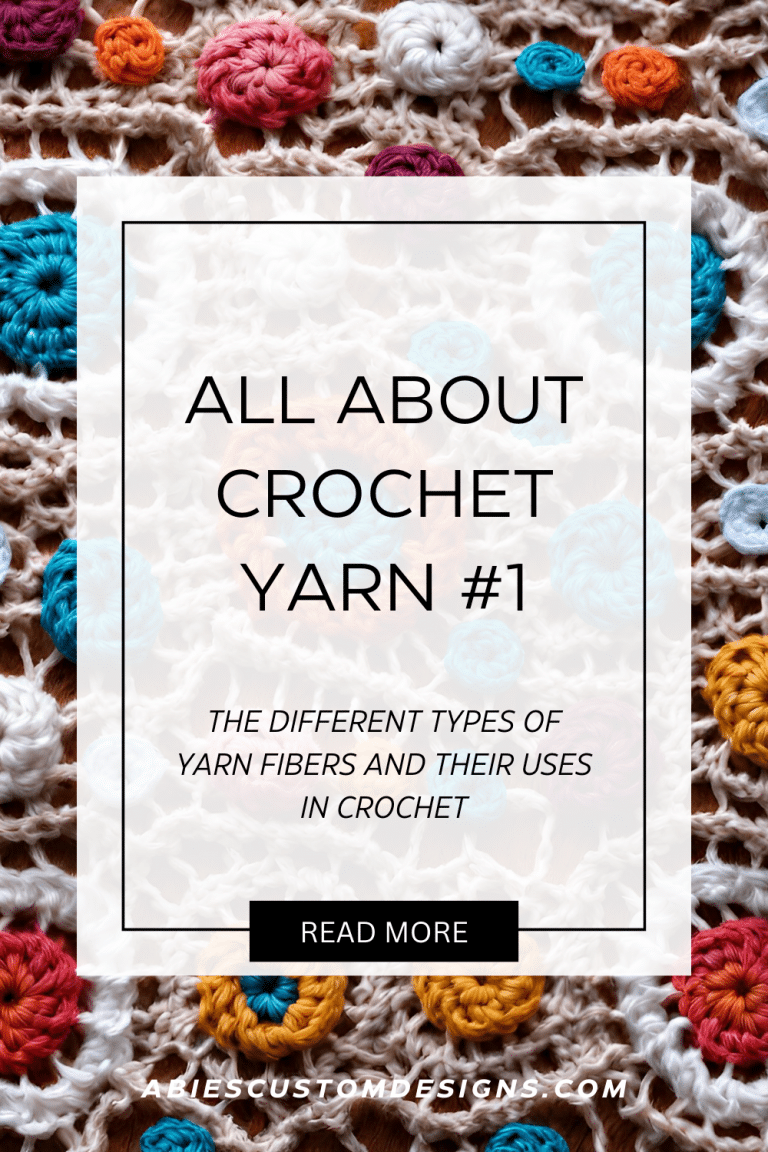Hey y’all!
Previously, I made an article about 7 Things to Know about Crochet Hooks. So, to go along with that, today we’ll be discussing the different yarn fibers and their uses in crochet.
There are so many different types, textures, and weights to consider when choosing yarn for a crochet project. Each one has their own unique qualities that makes them better for some projects and worse for others. For instance, cotton is good for its absorbency and washability, as well as for cool summer clothing, while acrylic is good for things like blankets because it’s warm.
In this post, we’ll be talking about the different yarn fibers, natural and synthetic, as well as their advantages and disadvantages.
Read on if that sounds interesting!
Disclosure: This post may contain affiliate links and I may receive a commission if you purchase through them, at no extra cost to you.
Most popular yarn materials:
I made a poll in r/crochet on reddit asking about everyone’s favorite yarn materials to crochet with. 314 people voted, and these were the results:
(here’s the link if anyone’s curious)

As you can see, the favorite was cotton yarn, followed closely by acrylic yarn. Then wool, bamboo, and silk. Some other mentions in the comments include:
Cotton/Acrylic yarn blend: 1
Cotton/Wool yarn blend: 2
Velvet/Chenille yarn: 2
Polyester yarn: 1
Types of yarn fibers and their uses in crochet
Natural Fibers
Natural fiber yarns are spun from plant or animal sources, offering different textures, colors, and properties. These types of fibers have many different advantages. One of the most significant advantages of using natural fiber yarns is their sustainability.
Some other advantages include:
Biodegradability:
Natural fibers decompose naturally, reducing environmental impact and waste.
Renewability:
Plants and animals from which natural fibers are sourced can be replenished seasonally, making these yarns a renewable resource.
Low Carbon Footprint:
The production processes for natural fibers tend to have lower carbon footprints compared to synthetic fibers.
Non-Toxic:
Natural fibers are often free from harmful chemicals, making them safer for environment.
However, they also have their disadvantages:
Sensitivity to Moisture:
Some natural fibers, like wool, can be sensitive to moisture and may felt if not handled correctly. Store your woolen creations carefully.
Dye Variations:
Natural fiber yarns can exhibit variations in color due to their organic origin.
Blocking:
Natural fibers often benefit from blocking to shape and finish projects. Follow specific blocking instructions for each type of yarn.
Gentle Care:
Natural fiber yarns may require more delicate care when washing and storing to maintain their integrity and softness.
These don’t apply to every natural fiber yarn, so be sure to read the yarn label for the specific kind that you’re using.
Types of natural fiber yarn:
Cotton
Cotton yarn is soft, breathable, and absorbent. It’s easier to wash than other materials, so it’s popular for projects that would need washing. This includes clothing, blankets, pillows, dishcloths, and towels.
It’s a natural fiber yarn and is hypoallergenic so it’s perfect for babies and people with sensitive skin. Though, since it’s so breathable, it doesn’t make for a warm blanket.
If you want to read more about cotton yarn, I have a post that goes in-depth and answers some frequently asked questions. You can read that here: All About Crocheting with Cotton Yarn.
Wool
Wool yarn is warm, moisture wicking, and odor resistant. It’s also quite durable and projects made with it will last a long time. High quality wool can also be very soft. It’s great for projects such as hats, scarves, gloves, socks, and anything else that would keep you warm.
If you want to read more about cotton yarn, I have a post that goes in-depth on wool yarn. You can read that here: All About Crocheting with Wool Yarn.
Silk
Silk yarn is very luxurious and elegant. It has a silky, smooth texture and has a natural sheen to it. It’s very breathable and also hypoallergenic so it’s great for wearables. Silk also has a special property that makes it resistant to mold and mildew. Because it has a natural drape and is very breathable, silk yarn is great for shawls, scarves, head-wraps, and other similar items.
If you want to read more about silk yarn, I have a post that goes in-depth on it. You can read that here: All About Crocheting with Silk Yarn.
Bamboo
Bamboo yarn is very sustainable since it’s made from the pulp of bamboo grass. Bamboo plants grow quickly without the need for pesticides or fertilizers, making it an environmentally friendly choice for yarn. Additionally, the production process of bamboo yarn is often considered more eco-friendly than that of synthetic fibers.
It’s also hypoallergenic, breathable, antibacterial, and durable. Like silk yarn, it has a wonderful drape and sheen that makes it perfect for shawls, wraps, sweaters, and other similar items.
Synthetic Fibers
Synthetic fiber yarns are made from petroleum and coal. These types of fibers also have many different advantages. One of the most significant advantages of using natural fiber yarns is their low cost.
Some other advantages include:
Affordability:
Synthetic yarns are often more budget-friendly than natural fibers like cotton or wool, making them a cost-effective choice. Acrylic and polyester yarn tends to be about $0.01 per foot of weight 4 yarn, while nylon yarn tends to be about $0.02 per foot of weight 4 yarn.
Durability:
Synthetic yarns are generally more durable and less prone to stretching, shrinking, or breaking compared to some natural fibers. This makes them suitable for items that need to withstand wear and tear, such as blankets or amigurumi.
Color Variety:
Synthetic yarns come in a wide range of vibrant and long-lasting colors. You can find them in many different shades and even variegated or self-striping options.
Hypoallergenic:
Synthetic yarns are typically hypoallergenic, making them a good choice for people with allergies to natural fibers like wool.
Ease of Care:
Many synthetic yarns are easy to care for, as they are machine-washable and resistant to stains and fading. This makes them suitable for items that need frequent washing, like baby blankets or kitchen accessories.
However, they also have their disadvantages:
Less Breathable:
This ones both an advantage and disadvantage depending on the project. Synthetic yarns do not breathe as well as natural fibers like cotton or wool. This means they may not be the best choice for items you want to wear in hot weather, as they can trap heat and moisture. But they’re great for cold weather items.
Environmental Impact:
The production of synthetic yarns often involves the use of petroleum-based materials, which can have a negative impact on the environment. Additionally, synthetic yarns are not biodegradable, making them less eco-friendly than natural fibers.
Less Soft:
While there are softer synthetic yarns available, many tend to be less soft and can sometimes feel scratchy or stiff. This may not be ideal for projects like scarves, shawls, or garments that come into direct contact with the skin.
Melting Risk:
Synthetic yarns can melt when exposed to high temperatures, so they are not suitable for projects that might come in contact with high heat sources.
Types of synthetic fiber yarn:
Acrylic
Acrylic yarn is inexpensive (~$0.01 per foot of weight 4 yarn) and available in a wide array of colors. It’s also extremely durable, holds its shape well, and very warm. This makes it a popular choice for crochet.
Acrylic yarn is great for many different types of projects. From amigurumi, to warm clothes, to blankets, you can use acrylic yarn for almost anything.
Polyester
Polyester yarn is another popular synthetic yarn. It’s similar to acrylic yarn in that it holds shape well, is very durable, and easy to care for, while being very cheap. It’s also a bit elastic and is wrinkle resistant.
Polyester yarn, like acrylic, is great for many different types of projects: amigurumi, blankets, bags, dishcloths, pillows, et cetera.
Nylon
Nylon yarn is very unique. It’s a very durable yarn that’s also very elastic. It can be stretched out and then bounce right back to its original shape. Nylon also has a shiny finish and is naturally resistant to moisture which allows it to dry quickly.
These properties make nylon yarn great for swimwear and beach cover ups, but you can also use it for things like headbands, bags, table runners, and more.
Blends
Yarn blends are made by combining two or more different types of yarn fibers. This makes these blended yarns very unique.
Here are a few popular blends:
- Acrylic and Wool Blend: This blend combines the affordability and durability of acrylic with the warmth and softness of wool. It’s a popular choice for various projects, including blankets, scarves, and hats.
- Cotton and Bamboo Blend: This blend offers the breathability of cotton with the softness and sheen of bamboo. It’s excellent for lightweight and summer-appropriate items, such as tops, baby blankets, and market bags.
- Cotton and Linen Blend: A blend of cotton and linen provides a crisp, natural texture with good breathability. It’s often used for summer garments and home decor items like dishcloths and table linens.
- Alpaca and Silk Blend: Blending alpaca with silk results in a luxurious, soft yarn with a lovely drape and sheen. This blend is suitable for shawls, delicate garments, and accessories.
- Nylon and Wool Blend: This blend combines the strength and durability of nylon with the warmth of wool. It’s often used for sock yarn to increase durability.
Types of yarn fibers chart
| Yarn Fibers | Natural or Synthetic | Advantages | Disadvantages |
| Cotton | Natural | Soft, breathable, and absorbent | Not very elastic, can shrink, can be expensive |
| Wool | Natural | Warm, moisture wicking, and odor resistant | Cost, allergy risk, maintenance, and pilling |
| Silk | Natural | Silky, nice sheen, breathable, resistant to mold and mildew | Cost, delicate, needs special care |
| Bamboo | Natural | Very eco-friendly, breathable, antibacterial, durable | Minimal stretch, needs special care, limited colors |
| Acrylic | Synthetic | Inexpensive, lots of colors, durable, warm, holds shape | Can be stiff, minimal stretch, not as breathable, can pill |
| Polyester | Synthetic | Durable, low maintenance, affordable, color retention | Can be stiff, minimal stretch, not as breathable |
| Nylon | Synthetic | Durable, strong, water-resistant, quick drying, elastic | Not as breathable |
Share on Pinterest to Read Later!

More Crochet Information Posts
7 Important Things to Know About Crochet Hooks
The Ultimate Guide to Amigurumi: Crafting Adorable Crochet Creations
How to Crochet a Flat Circle for Beginners – Free Coaster Pattern
And that’s all folks!
Hope you enjoyed this article all about crochet yarn. Let me know if you have any questions. And don’t forget to pin this post on Pinterest to save it for later!


